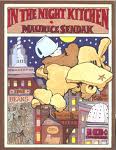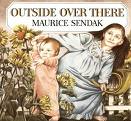Where the Wild Things Are

by Maurice Sendak. ![]() Picture Book. 48 pages. Grades PreK-12.
Picture Book. 48 pages. Grades PreK-12.
Find this book: Amazon

Teacher's Guide

This classic picture book has delighted generations of children while jangling the nerves of some less intrepid adults and children. With a perfect marriage of text and illustration, Sendak propels us and Max from his home where he and his mother shout with rage at each other across time and place to where the wild things are.
In the opening scenes Max wears his wolf suit and creates havoc. His angry mother yells at him and he yells back whereupon he is sent to bed without his supper. His room is transformed into a magic forest and Max sets off in his very own boat to the land of the wild things.
Once there he tames the monsters by staring into their yellow eyes without blinking. Knowing they have met their master, they acclaim Max King of all wild things and celebrate their wildness together. When Max decides to return to where someone loves him best of all, the wild things try all their wiles to persuade him to stay, but he sails back into the warmth of his own room.
Max's world when he is "making mischief of one kind and another" is small and the picture occupies a small place on the page. As he gains supremacy and control, his world as represented by the illustrations grows bigger until the picture occupies the full page and even spreads onto the next page. The illustrations then proceed down the page until they have driven off all print by the time the "wild rumpus" starts.
Later, when Max smells good things to eat, the world grows smaller, but never gets as small as it once was. Sendak used cross-hatching with pen and ink over colored paint to create a the balance of silliness and subtlety that marks this classic.
It can truly be said that Sendak changed the look of books for young children and became an indelible part of American popular culture. When Where the Wild Things Are was published in 1963, Sendak’s monsters were often considered much too frightening for children. Today children are apt to take stuffed likenesses of these creatures to bed with them.
It's hard to realize now, looking at this classic and comparatively tame picture book, that it caused a great furor when it was published in the early 1960's. Many people were shocked to see monsters in a book for very young children. There hadn't been any, really, other than fairy tales. Other people were upset because Max does bad things and ends up having a great time. Bruno Bettleheim, an eminent psychiatrist of the time, was less worried about the monsters than he was of the treatment of Max's anger and misbehavior both of which were left unbridled and unpunished. He said that many children would be traumatized by the book. When the book got the Caldecott Award, the furor increased. Some librarians refused to buy it for their collections. Protest groups were organized by some conservative organizations. Learning about this book's history could lead to dialogues about censorship especially with older children.
(Continued Below)
Advertisement:

Things to Talk About and Notice
- Debate whether Max dreamed, imagined or really went on his voyage. What evidence can you cite?

- Mr. Sendak has said that this book together with In the Night Kitchen and Outside Over There are his trilogy of childhood. Discuss what Sendak might have been trying to tell us in these books. Are there any common threads between them.
- How much time do you think passed between the first and last pages of the book? There are a lot of contradictory clues in the book. How will you resolve these?
- This is a good book for identifying the difference between fantasy and reality in literature. Find the first spot in the book where something fantastic happens. How does Sendak keep the fantasy world consistent with itself?
- Notice the way Sendak starts the story in such a way as to make us believe it: not with “Once upon a time” but with the declarative: “The night Max wore his wolf suit.”
- Look again at the way Max assumes control over the wild things when he gets there. Maurice Sendak could have had him do it with a whip or a gun. How does Sendak’s choice of words and action here affect the story?
- Look at the illustrations. Notice the way Sendak uses tiny ink lines to show the hairs on the Wild Things and makes cross hatch lines to show whether things are close up or far back. Compare his illustrations with those in other picture books.

Activities
- Find all the signs in Max's home that foreshadow the wild things adventure: the picture on the wall, the tent, the stool, and the words "I'll eat you up." This is great for discussing foreshadowing with older students as many of them will fondly remember Where the Wild Things Are. Make up other examples of foreshadowing that Sendak could have used.
- Find the spot where the spoken words change from being printed as all capitals to normal print and decide what that might mean.
- Look for places in the story where time or distance are mixed up.
- Watch the moon in the illustrations as it goes through different phases. Find the names for those phases and see how long it would take to change from one to the other.
- Choose classical music to serve as background for an oral reading of the book.
- Expand the book into a dance or ballet.
- Turn the walls of the classroom into the land of the wild things.
- Using craft paper stuffed with newspapers make the characters.
- Mr. Sendak has said that when he was a child, his aunts would come to the apartment where he lived, pinch his cheeks and say, "Oh you're so cute! We could eat you up." Find other details from his life that he has put into his books, particularly In the Night Kitchen. See our author article on Maurice Sendak.
- Maurice Sendak often listens to Mozart as he works. Play some of Mozart’s music and create a work of art. Did the music help?
(Continued Below)
Advertisement:

Related Books
 Outside Over There by Maurice Sendak. (Harper, 1981 ISBN 0064431851. Order Info.)
Outside Over There by Maurice Sendak. (Harper, 1981 ISBN 0064431851. Order Info.)
This is a book with many details which lend themselves to different interpretations. For instance, the entire fantasy may take place in a instant and the storm at sea could symbolize Ida's fury at the kidnapping of her baby sister.- In The Night Kitchen by Maurice Sendak. (1996, HarperCollins. ISBN 0060266686. Order Info.)
This cartoon like book has echoes of Where the Wild Things Are and contains many allusions to the period of the author's childhood.
(Continued Below)
Advertisement:

Related Areas Within Carol Hurst's Children's Literature Web Site
- Maurice Sendak: Featured Author Article
- There is more about using Where the Wild Things Are and the other two books in Sendak's "trilogy of childhood" with older students in our Using Literature in the Middle School Curriculum.
- Free Teacher's Guides: A listing of all our teacher's guides. Picture Books, Nonfiction and Fiction.

